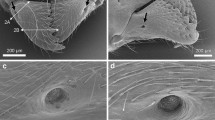Summary
A novel glandular structure is described within the mandibles of a series of representatives of the Formicidae. It consists of a variable number of secretory cells with their accompanying duct cells, located in the vicinity of the mandibular cuticle. Because of its localization inside the mandibles, we propose to designate this structure as the intramandibular gland of ants. Ultrastructural observations reveal the development of smooth endoplasmic reticulum in the glandular cells. Several electron-lucid and electron-dense inclusions occur in the cytoplasm. Until now, the function of this widespread gland among the Formicidae remains unknown.
Similar content being viewed by others
References
Ågren L (1978) Malar gland: A new cephalic gland in Cerceris rybyensis L. (Hymenoptera: Philanthidae). Int J Insect Morphol Embryol 7:479–481
Bazire-Bénazet M, Zylberberg L (1979) An integumentary gland secreting a territorial pheromone in Atta sp.: detailed structure and histochemistry. J Insect Physiol 25:751–765
Billen JPJ (1987) Morphology and ultrastructure of the exocrine glands in social Hymenoptera. In: Eder I (eds) Chemistry and biology of social insects. J. Peperney, München
Billen JPJ (1989) Morphology of the cloacal gland in the ant Cataglyphis savignyi. Actes Coll Insectes Soc 5:301–306
Billen JPJ (1990) The sting bulb gland in Myrmecia and Nothomyrmecia (Hymenoptera: Formicidae): A new exocrine gland in ants. Int J Insect Morphol Embryol 19:133–139
Billen JPJ (1994) Morphology and classification of the exocrine glands in ants. Ari (in press)
Costa Leonardo AM (1978) Glandulas intramandibulares em abelhas sociais. Ciênc Cult 30:835–838
Cruz-Landim C (1962) Evaluation of the wax and scent glands in the Apinae (Hymenoptera: Apidae). J NY Entomol Soc 21:2–13
Delfino G, Piccioli MTM, Calloni C (1983) Ultrastructure of the venom glands in Polistes gallicus (L.) (Hymenoptera Vespidae) Monit Zool Ital (NS) 17:263–277
Deligne J, Quennedey A, Blum MS (1981) The enemies and defense mechanisms of termites. In: Hermann HR (ed) Social insects, vol 2. Academic Press, New York
Hefetz A (1987) The role of Dufour's gland secretions in bees. Physiol Entomol 12:243–253
Hölldobler B (1982) The cloacal gland, a new pheromone gland in ants. Naturwissenschaften 69:186–187
Hölldobler B, Engel H (1978) Tergal and sternal glands in ants. Psyche 85:285–330
Hölldobler B, Engel H (1982) Tergal and sternal glands in male ants. Psyche 89:113–132
Hölldobler B, Engel-Siegel H (1984) On the metapleural gland of ants. Psyche 91:201–224
Jessen K, Maschwitz U (1983) Abdominaldrüsen bei Pachycondyla tridentata (Smith): Formicidae, Ponerinae. Ins Soc 30:123–133
Jessen K, Maschwitz U, Hahn M (1979) Neue Abdominaldrüsen bei Ameisen. I. Ponerini (Formicidae: Ponerinae). Zoomorphologie 94:49–66
Landolt PJ, Akre RD (1979) Occurrence and location of exocrine glands in some social Vespidae (Hymenoptera). Ann Entomol Soc Am 72:141–148
Leuthold RH (1968) A tibial gland scent-trail and trail-laying behavior in the ant Crematogaster ashmeadi Mayr. Psyche 75:233–248
Nedel JO (1960) Morphologie und Physiologie der Mandibeldrüse einiger Bienen-Arten (Apidae). Z Morphol Ökol Tiere 49:139–183
Noirot C, Quennedey A (1974) Fine structure of insect epidermal glands. Ann Rev Entomol 19:61–80
Peeters C, Billen J (1991) A novel exocrine gland inside the thoracic appendages (‘gemmae’) of the queenless ant Diacamma australe. Experientia 47:229–231
Schoeters E, Billen J (1992) Morphological and ultrastructural study of the metapleural gland in Diacamma (Hymenoptera, Formicidae). In: Billen J (ed) Biology and evolution of social insects. Leuven University Press, Leuven (Belgium)
Stort AC, Bueno de Moraes MM, Barelli N (1986) Scanning electron microscopy observations of the mandibles of Scaptotrigona postica workers (Hymenoptera, Apoidea). J Apic Res 25:65–70
Toledo LF de A (1967) Histo-anatomia das glândulas de Atta sexdens rubropilosa Forel (Hymenoptera). Arq Inst Biol Sao Paulo 34:321–329
Author information
Authors and Affiliations
Rights and permissions
About this article
Cite this article
Schoeters, E., Billen, J. The intramandibular gland, a novel exocrine structure in ants (Insecta, Hymenoptera). Zoomorphology 114, 125–131 (1994). https://doi.org/10.1007/BF00396645
Accepted:
Issue Date:
DOI: https://doi.org/10.1007/BF00396645




